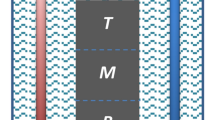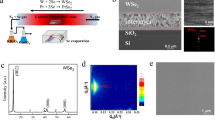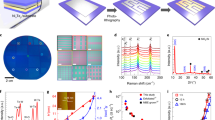Abstract
Two-dimensional transition metal selenides (TMSs) possess fascinating physical properties. However, many as-prepared TMSs are environmentally unstable and limited in sample size, which greatly hinder their wide applications in high-performance electrical devices. Here we develop a general two-step vapour deposition method and successfully grow different TMS films with controllable thickness, wafer size and high quality. The superconductivity of the grown NbSe2 film is comparable with sheets exfoliated from bulk materials, and can maintain stability after a variety of harsh treatments, which are ascribed to the absence of oxygen during the whole growth process. Such environmental stability can greatly simplify the fabrication procedure for device applications, and should be of both fundamental and technological significance in developing TMS-based devices.
This is a preview of subscription content, access via your institution
Access options
Access Nature and 54 other Nature Portfolio journals
Get Nature+, our best-value online-access subscription
$29.99 / 30 days
cancel any time
Subscribe to this journal
Receive 12 print issues and online access
$259.00 per year
only $21.58 per issue
Buy this article
- Purchase on Springer Link
- Instant access to full article PDF
Prices may be subject to local taxes which are calculated during checkout




Similar content being viewed by others
Data availability
The data that support the findings of this study are available from the corresponding author upon request.
References
Geim, A. K. & Grigorieva, I. V. Van der Waals heterostructures. Nature 499, 419–425 (2013).
Xia, F. N., Wang, H., Xiao, D., Dubey, M. & Ramasubramaniam, A. Two-dimensional material nanophotonics. Nat. Photon. 8, 899–907 (2014).
Joe, Y. I. et al. Emergence of charge density wave domain walls above the superconducting dome in 1T-TiSe2. Nat. Phys. 10, 421–425 (2014).
Xi, X. et al. Strongly enhanced charge-density-wave order in monolayer NbSe2. Nat. Nanotechnol. 10, 765–770 (2015).
Li, L. J. et al. Controlling many-body states by the electric-field effect in a two-dimensional material. Nature 529, 185–189 (2016).
Xi, X. et al. Ising pairing in superconducting NbSe2 atomic layers. Nat. Phys. 12, 139–143 (2016).
Ge, J.-F. et al. Superconductivity above 100 K in single-layer FeSe films on doped SrTiO3. Nat. Mater. 14, 285–289 (2015).
Ye, J. T. et al. Superconducting dome in a gate-tuned band insulator. Science 338, 1193–1196 (2012).
Favron, A. et al. Photooxidation and quantum confinement effects in exfoliated black phosphorus. Nat. Mater. 14, 826–832 (2015).
Shcherbakov, D. et al. Raman spectroscopy, photocatalytic degradation, and stabilization of atomically thin chromium tri-iodide. Nano Lett. 18, 4214–4219 (2018).
Chhowalla, M. et al. The chemistry of two-dimensional layered transition metal dichalcogenide nanosheets. Nat. Chem. 5, 263–275 (2013).
Ugeda, M. M. et al. Characterization of collective ground states in single-layer NbSe2. Nat. Phys. 12, 92–97 (2015).
Hotta, T. et al. Molecular beam epitaxy growth of monolayer niobium diselenide flakes. Appl. Phys. Lett. 109, 133101 (2016).
Chen, P. et al. Charge density wave transition in single-layer titanium diselenide. Nat. Commun. 6, 8943 (2015).
Li, X. et al. Large-area synthesis of high-quality and uniform graphene films on copper foils. Science 324, 1312–1314 (2009).
Lu, G. et al. Synthesis of large single-crystal hexagonal boron nitride grains on Cu–Ni alloy. Nat. Commun. 6, 6160 (2015).
Lee, Y.-H. et al. Synthesis of large-area MoS2 atomic layers with chemical vapor deposition. Adv. Mater. 24, 2320–2325 (2012).
Zhou, L. et al. Large-area synthesis of high-quality uniform few-layer MoTe2. J. Am. Chem. Soc. 137, 11892–11895 (2015).
Kang, K. et al. High-mobility three-atom-thick semiconducting films with wafer-scale homogeneity. Nature 520, 656–660 (2015).
Wang, H. et al. High-quality monolayer superconductor NbSe2 grown by chemical vapour deposition. Nat. Commun. 8, 394 (2017).
Zhou, J. et al. A library of atomically thin metal chalcogenides. Nature 556, 355–359 (2018).
Li, S. et al. Vapour-liquid-solid growth of monolayer MoS2 nanoribbons. Nat. Mater. 17, 535–542 (2018).
Zhou, L. et al. Synthesis of high-quality large-area homogenous 1T’ MoTe2 from chemical vapor deposition. Adv. Mater. 28, 9526–9531 (2016).
Kim, A. R. et al. Alloyed 2D metal-semiconductor atomic layer junctions. Nano Lett. 16, 1890–1895 (2016).
Zhan, Y., Liu, Z., Najmaei, S., Ajayan, P. M. & Lou, J. Large-area vapor-phase growth and characterization of MoS2 atomic layers on a SiO2 substrate. Small 8, 966–971 (2012).
Lin, Y.-C. et al. Wafer-scale MoS2 thin layers prepared by MoO3 sulfurization. Nanoscale 4, 6637–6641 (2012).
Laskar, M. R. et al. Large area single crystal (0001) oriented MoS2. Appl. Phys. Lett. 102, 252108 (2013).
Nemes-Incze, P., Osvath, Z., Kamaras, K. & Biro, L. P. Anomalies in thickness measurements of graphene and few layer graphite crystals by tapping mode atomic force microscopy. Carbon 46, 1435–1442 (2008).
Saito, R., Tatsumi, Y., Huang, S., Ling, X. & Dresselhaus, M. S. Raman spectroscopy of transition metal dichalcogenides. J. Phys. Condens. Matter 28, 353002 (2016).
Hong, J. H. et al. Exploring atomic defects in molybdenum disulphide monolayers. Nat. Commun. 6, 6293 (2015).
Reyren, N. et al. Superconducting interfaces between insulating oxides. Science 317, 1196–1199 (2007).
Tinkham, M. Introduction to Superconductivity (McGraw-Hill, 1996).
López-Polín, G. et al. Increasing the elastic modulus of graphene by controlled defect creation. Nat. Phys. 11, 26–31 (2015).
Sun, L. et al. Suppression of the charge density wave state in two-dimensional 1T-TiSe2 by atmospheric oxidation. Angew. Chem. Int. Ed. 56, 8981–8985 (2017).
Kim, M. et al. Strong proximity Josephson coupling in vertically stacked NbSe2–graphene–NbSe2 van der Waals junctions. Nano Lett. 17, 6125–6130 (2017).
Acknowledgements
We thank W. Jiang, B. Li and Y. Dai for help with absorption measurements, and W. Chen and Y. Zhang for help with XPS measurements. This work is supported by the National Key R&D Program of China (grant no. 2018YFA0305800), the National Natural Science Foundation of China (nos. 11674154, 11761131010, 11774151 and 51771172) and the Fundamental Research Funds for the Central Universities (nos. 020414380065 and 020414380094 and 02041438100), and the Basic Research Program of Jiangsu Province (grant no. BK20161390). The numerical calculations have been carried out at the High Performance Computing Center of Nanjing University.
Author information
Authors and Affiliations
Contributions
L.G. conceived and supervised the project, and designed the experiments; H.L. carried out growth experiments and transport measurements; J.X., X.H. and W.S. helped with the device fabrication and transport measurements; Q.Z. and J.W. performed STEM; D.L. and X.X. performed the terahertz Raman spectroscopy; D.S. carried out the theoretical simulations; L.G. and H.L. wrote the manuscript, J.W., Q.Z., J.X. and X.X. revised it, and all of the authors commented on it.
Corresponding authors
Ethics declarations
Competing interests
The authors declare no competing interests.
Additional information
Publisher’s note: Springer Nature remains neutral with regard to jurisdictional claims in published maps and institutional affiliations.
Supplementary Information
Supplementary Information
Supplementary Figures 1–18, Supplementary References 1–6
Rights and permissions
About this article
Cite this article
Lin, H., Zhu, Q., Shu, D. et al. Growth of environmentally stable transition metal selenide films. Nat. Mater. 18, 602–607 (2019). https://doi.org/10.1038/s41563-019-0321-8
Received:
Accepted:
Published:
Issue Date:
DOI: https://doi.org/10.1038/s41563-019-0321-8
This article is cited by
-
Defect-induced helicity dependent terahertz emission in Dirac semimetal PtTe2 thin films
Nature Communications (2024)
-
From VIB- to VB-Group Transition Metal Disulfides: Structure Engineering Modulation for Superior Electromagnetic Wave Absorption
Nano-Micro Letters (2024)
-
Vapour-phase deposition of two-dimensional layered chalcogenides
Nature Reviews Materials (2023)
-
Oxidation kinetics and non-Marcusian charge transfer in dimensionally confined semiconductors
Nature Communications (2023)
-
Stack growth of wafer-scale van der Waals superconductor heterostructures
Nature (2023)



